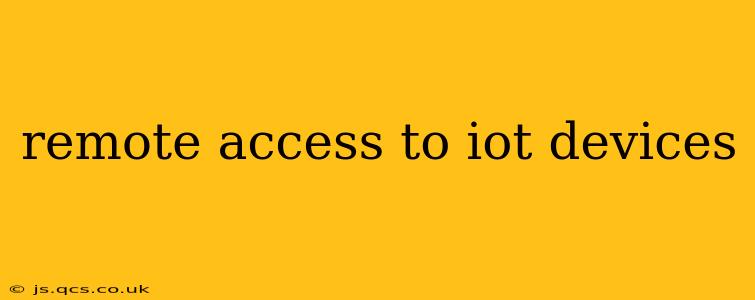The Internet of Things (IoT) has revolutionized how we interact with the world, connecting everyday devices to the internet and enabling remote monitoring and control. However, this connectivity also introduces significant security and accessibility challenges. This guide explores the intricacies of remote access to IoT devices, covering various methods, security considerations, and best practices.
What is Remote Access to IoT Devices?
Remote access to IoT devices refers to the ability to monitor, control, and manage these devices from a location other than their physical vicinity. This is achieved through various communication protocols and network technologies, allowing users to interact with their smart home appliances, industrial machinery, or wearable devices from anywhere with an internet connection. This capability unlocks a wide range of possibilities, from adjusting your thermostat remotely to remotely monitoring the performance of critical infrastructure.
How to Access IoT Devices Remotely?
Several methods facilitate remote access, each with its own advantages and disadvantages:
1. Cloud-Based Platforms:
Many IoT devices utilize cloud platforms as an intermediary for remote access. These platforms provide a central hub for managing multiple devices, offering features such as dashboards, alerts, and remote control functionalities. Examples include AWS IoT Core, Azure IoT Hub, and Google Cloud IoT Core. The cloud provider handles the complexities of communication and security, simplifying the process for users.
2. VPN (Virtual Private Network):
A VPN creates a secure, encrypted connection between your device and the IoT device, shielding your data from eavesdropping. This is particularly useful for accessing devices on a private network, such as a home network with security cameras or smart locks. VPNs provide a robust layer of security, essential for sensitive applications.
3. Direct Connection via IP Address:
This method involves accessing the device directly using its IP address and port number. However, this requires a good understanding of networking and is generally less secure than cloud-based solutions or VPNs. It’s also less convenient, often requiring port forwarding configuration on your router.
4. Mobile Apps:
Most modern IoT devices come with dedicated mobile applications (iOS and Android) designed for remote control. These apps usually provide user-friendly interfaces and require minimal technical expertise. However, the security and functionality of these apps can vary significantly depending on the manufacturer.
What are the Security Risks of Remote Access to IoT Devices?
Remote access to IoT devices exposes them to several security risks:
Unauthorized Access:
Malicious actors could exploit vulnerabilities in the device or network to gain unauthorized access, potentially causing data breaches, device malfunction, or even physical harm.
Data Breaches:
Sensitive data transmitted between the device and the user could be intercepted if security measures are inadequate.
Denial-of-Service (DoS) Attacks:
Attackers can flood the device with requests, making it unavailable to legitimate users.
Malware Infection:
IoT devices can become infected with malware, transforming them into part of a botnet or stealing data.
How to Secure Remote Access to IoT Devices?
Robust security measures are paramount for mitigating the risks associated with remote access.
Strong Passwords and Authentication:
Use strong, unique passwords for all devices and accounts. Implement multi-factor authentication (MFA) wherever possible for enhanced security.
Regular Software Updates:
Keep the firmware of your IoT devices and the software on your access point updated to patch security vulnerabilities.
Network Segmentation:
Isolate your IoT devices on a separate network segment from your other devices to limit the impact of a potential breach.
Firewall Configuration:
Configure your firewall to block unauthorized access attempts and only allow connections from trusted sources.
Encryption:
Utilize encryption protocols, such as TLS/SSL, to protect data transmitted between the devices and the access point.
What are some common IoT device protocols for remote access?
Several protocols enable communication and remote access for IoT devices, each with its own strengths and weaknesses:
- MQTT (Message Queuing Telemetry Transport): A lightweight, publish-subscribe protocol ideal for resource-constrained devices.
- CoAP (Constrained Application Protocol): Designed for low-power and constrained networks, frequently used in IoT applications.
- HTTP: The widely used protocol for web communication, also utilized for remote access to some IoT devices.
- AMQP (Advanced Message Queuing Protocol): A robust message-oriented middleware protocol suitable for reliable messaging in IoT systems.
How can I choose the right remote access method for my IoT devices?
The optimal remote access method depends on various factors:
- Security requirements: For sensitive data, VPNs or cloud platforms with robust security measures are recommended.
- Device capabilities: Resource-constrained devices may necessitate lightweight protocols like MQTT.
- Technical expertise: Cloud-based platforms or mobile apps offer simpler management for less technically inclined users.
- Scalability: Cloud platforms offer better scalability for managing a large number of devices.
By carefully considering these factors and implementing robust security measures, you can safely and effectively leverage the benefits of remote access to your IoT devices. Remember, continuous monitoring and proactive security updates are crucial for maintaining a secure and reliable IoT ecosystem.
